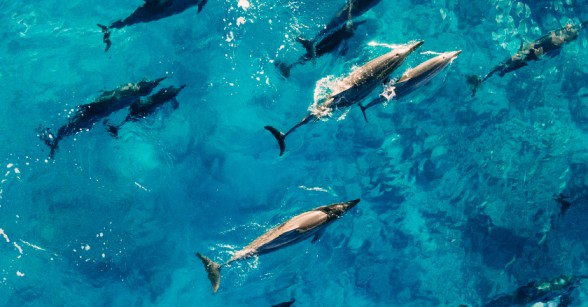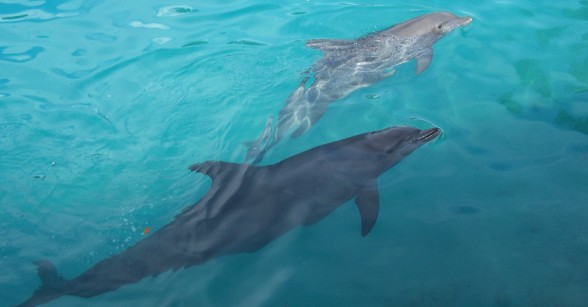
“Dive into the captivating world of dolphin communication! Explore their intricate language and social dynamics in this enlightening article.”
Introduction
Dolphins are renowned for their intelligence and complex social behaviors. One of the most fascinating aspects of their lives is how they communicate with each other. Understanding dolphin communication sheds light on their intricate world beneath the waves.
The Complexity of Dolphin Communication
Dolphin communication stands out among marine species for its remarkable complexity. Over millions of years of evolution, these creatures have developed an intricate system of signals, sounds, and body language to convey information.
Vocalizations and Sounds
One of the primary means of communication for dolphins is through vocalizations. These include clicks, whistles, and pulsed sounds. Each sound serves a distinct purpose. Clicks, for instance, are used for echolocation, helping dolphins navigate and locate prey.
Echolocation
Echolocation is a skill unique to certain marine mammals, including dolphins. It’s a form of biological sonar, allowing them to “see” their environment by emitting high-frequency sounds and interpreting the echoes that bounce back. This remarkable ability is a testament to the sophistication of their communication system.

Whistles and Signature Whistles
Whistles play a crucial role in dolphin communication. They serve as a way to convey identity, intent, and emotions. Within this category, there’s something truly special – signature whistles. Every dolphin develops its own unique signature whistle, akin to a name. This distinctive call fosters individual recognition within their social groups.
Body Language and Gestures
While vocalizations are significant, dolphins also communicate through body language and gestures. They employ a range of movements like leaps, tail slaps, and specific postures to convey various messages. This non-verbal communication is integral to their interactions, especially within their pods.
Group Dynamics and Social Structure
Communication is the cornerstone of dolphin society. Within a pod, intricate hierarchies and social roles are established and maintained through effective communication. Whether it’s coordinating hunting efforts or nurturing young calves, clear signals ensure seamless cooperation.
Cultural Variations in Dolphin Communication
Remarkably, different dolphin populations exhibit distinct dialects or communication patterns. These variations hint at cultural diversity among these intelligent creatures. Scientists have made fascinating discoveries by studying these unique linguistic traits.
Human Interaction and Its Impact
Sadly, human activities can disrupt the delicate balance of dolphin communication. Noise pollution from shipping and recreational boating can interfere with their ability to convey vital information. Efforts are underway to develop technologies and implement regulations that safeguard these vital channels of communication.

Conclusion
Studying dolphin communication is akin to deciphering a captivating underwater language. It not only deepens our understanding of these remarkable creatures but also highlights the need to protect their habitats. As we venture further into the realm of marine science, let’s remember the intricate world of communication that thrives beneath the waves.
- Do dolphins speak to each other?
- Yes, dolphins communicate with each other using a combination of vocalizations, body language, and gestures.
- How do dolphins send messages to each other?
- Dolphins send messages through a variety of vocalizations, including clicks, whistles, and pulsed sounds, as well as body language and gestures.
- How do dolphins communicate with each other for kids?
- Dolphins use special sounds and movements to talk to their dolphin friends. They have their own way of saying things!
- What are the communication signals of dolphins?
- Dolphins use clicks for echolocation, whistles for social interaction, and a variety of body movements like leaps and tail slaps to communicate.
- How do dolphins communicate and why?
- Dolphins communicate to share important information about their environment, find food, play, and socialize with their pod members.
- Can dolphins understand language?
- Dolphins can learn and understand some human-made signals and commands, but they have their own complex language too.
- Can dolphins hear humans talk?
- Yes, dolphins have excellent hearing and can hear humans talking, even underwater.
- How do dolphins see humans?
- Dolphins use their well-developed vision to see humans, but they also rely heavily on echolocation to “see” underwater.
- How intelligent are dolphins?
- Dolphins are highly intelligent marine mammals known for their problem-solving abilities, social complexity, and sophisticated communication skills.
- How do dolphins say hello?
- Dolphins may use friendly clicks and whistles, along with gentle body movements, to greet and acknowledge each other.
- How far can dolphins communicate?
- Dolphins can communicate over several miles using their sounds and echolocation.
- How do dolphins have friends?
- Dolphins form close bonds with certain pod members, often based on mutual interests and trust. They engage in playful and cooperative behaviors with their friends.
- Can dolphins show love?
- While it’s hard to define love in the same way humans experience it, dolphins do form strong, affectionate bonds with their pod members.
- How many words do dolphins know?
- While dolphins can learn and respond to a variety of human signals, they primarily rely on their own complex language, which humans are still learning to understand.
- Can dolphins learn English?
- Dolphins can learn to associate certain English words or signals with specific actions or objects, but they primarily communicate using their own natural language.
- Why do dolphins like humans?
- Dolphins are curious creatures, and they may show interest in humans who approach them in a friendly and non-threatening manner.
- Can dolphins teach each other?
- Yes, dolphins are known to engage in teaching behaviors, especially when it comes to hunting and other essential life skills.
- Why can dolphins communicate?
- Dolphins communicate to survive and thrive in their marine environment. Effective communication helps them find food, avoid predators, and navigate their surroundings.
- Do dolphins talk in their sleep?
- While it’s not entirely clear if dolphins experience a sleep state like humans, they do engage in periods of rest where their brain activity decreases. During these times, they may produce occasional sounds, but it’s not considered “talking” as we understand it.
- How do dolphins talk to babies?
- Dolphins communicate with their young through a combination of gentle vocalizations, body contact, and protective behaviors to ensure their safety and well-being.
You may be interested in reading this article: Shoebill Storks: The Living Fossils of the African Savannah. We also invite you to explore more of our captivating content on our channel. Double muak!

Pingback: Shoebill Storks: The Living Fossils of the African Savannah -
Pingback: The Dragon Blood Tree: The Tree That Bleeds Blood -